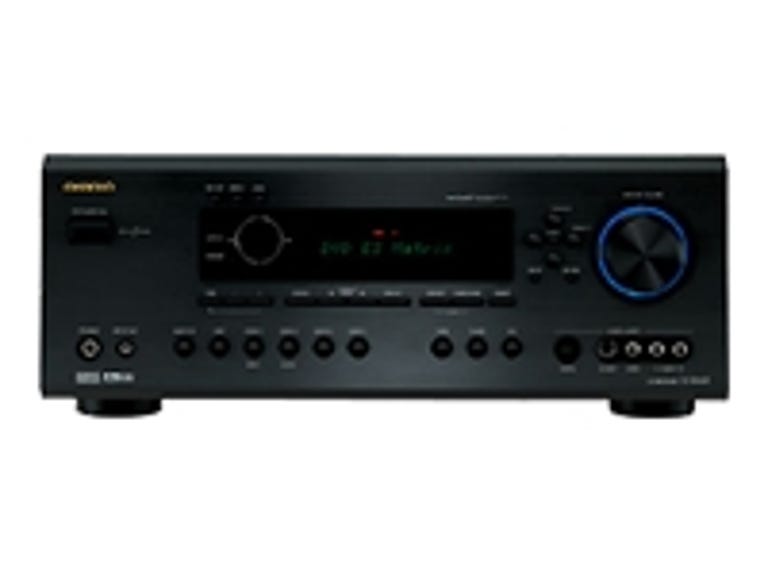As $500 receivers go, the Onkyo TX-SR602 is a fairly large, well-appointed unit that consumes 17 inches of shelf depth and weighs a solid 32.6 pounds. The handsome receiver is available in silver or black finishes.
The Good
The Bad
The Bottom Line
The large, partially backlit remote will be familiar to anyone who has used an Onkyo receiver over the past few years, and that's all right with us. Onkyo's remotes are among the most logically laid out and easiest to use, and it offers a full-size set of DVD player controls. Bass and treble controls are conveniently located on the receiver's front panel.
The SR602's automatic setup routine fell short of our expectations. The system gauges how many speakers you have hooked up, determines whether they're large or small in terms of their ability to handle bass, measures their distances from the listening position, and balances the volume levels of the speakers and the subwoofer. Well, that's what it's supposed to do, but in our tests, it failed to detect the presence of our subwoofer. We ran the autotest sequence a few more times without success, even after we manually raised its volume level and repositioned the setup microphone. We next tried to get the sub back in the game with the SR602's manual setup, but the receiver steadfastly refused our best efforts to access the setup menu (it had worked normally before we engaged the autosetup system).
We eventually spoke with an Onkyo engineer who shed a little light on the SR602's eccentricities. He suggested we turn our subwoofer's volume control all the way up and clued us into the receiver's secret reset routine (press the Video 1 button while powering down the SR602) so that we could go in and manually turn the subwoofer output back on--too bad Onkyo didn't include those tips in the owner's manual. In any case, we strongly recommend avoiding the autosetup--you'll have better results if you stick with the manual routine.
The Onkyo TX-SR602's power section includes 7 85-watt channels and all of the standard Dolby and DTS 7.1-channel surround processing schemes.
Connectivity provisions run to five separate A/V sources, all with S-Video and composite video--one set of inputs is on the front panel--and three of which can utilize component-video inputs. While the TX-SR602 can upconvert composite-video sources to S-Video, it can't output composite-video or S-Video sources via its component-video output as units such as Denon's AVR-1705 can. Onkyo also included a set of SACD/DVD-Audio inputs; two stereo sources plus tape output; and a total of six digital inputs--four optical (one on the front) and two coaxial inputs, plus one optical digital output.
A flexible second-zone feature allows the SR602 to power stereo speakers in a second room if you're content listening to "only" 5.1-channel sound in your home theater. The arrangement is similar to A/B speaker switching, but it's actually better because the SR602 can deliver sound from separate stereo sources to each zone--for instance, the CD in the main room and the radio in Zone 2. Don't worry, you can still send the same signal to both zones, and you can separately control the volume level for each zone. There's also a set of Zone 2 pre-out jacks for use with a remote power amplifier.
As we were working on this review in early May, Onkyo announced its entry-level TX-SR503, a 75-watt-times-7-channel receiver. It will retail for a mere $300.
The House of Flying Daggers DVD is loaded with sonic delights. We loved the scene where Zhang Ziyi dances within a circle of massive drums, and when Andy Lau flicks a bean over to one of the drums, it ricochets from drum to drum. The Onkyo TX-SR602 precisely rendered each drum thwack and the solidity of their thundering impacts. Later on, the clashing metal-against-metal swordplay sounded realistic, and at one point, Lau's sword set a shimmering curtain of glass beads clinking from all around us. It's an amazing effect. The virtuoso performances, both by the actors and by the SR602, made for a thrilling home-theater experience.
Led Zeppelin's How the West Was Won DVD-A disc sounds far better than the CD of the same title--at least we thought so when we played the DVD over the SR602. The 1972 live shows were recorded at the L.A. Forum and the Long Beach Arena, when the band was in great shape--Jimmy Page's full boogie guitar bravado and John Bonham's gargantuan drum kit kept us on the edge of our seats. The DVD-A unfurls vivid stage depth, and its holographic surround mix puts us in the best seats in the arena. When we got a little carried away and pushed the volume up beyond a certain point, we could feel the SR602 straining to let the good times roll. If you really want to get crazy, you'll need a receiver with more juice, but that's going to cost you a lot more than $500.
When we did a quick face-off with Denon's AVR-1705 ($400), we thought the two receivers sounded pretty much the same--both were excellent on DVD. When we played jazz diva Cassandra Wilson's CDs, we noted that the 1705 sounded a little richer, while the SR602 had a bit more resolution of fine details and grooved harder.
We don't usually mention FM radio performance in our reviews, but the SR602's above-par reception and sound quality deserves highlighting. Even the most feebly powered college radio stations were coming in loud and clear. By way of comparison, the best stations sounded a lot better than satellite radio.



